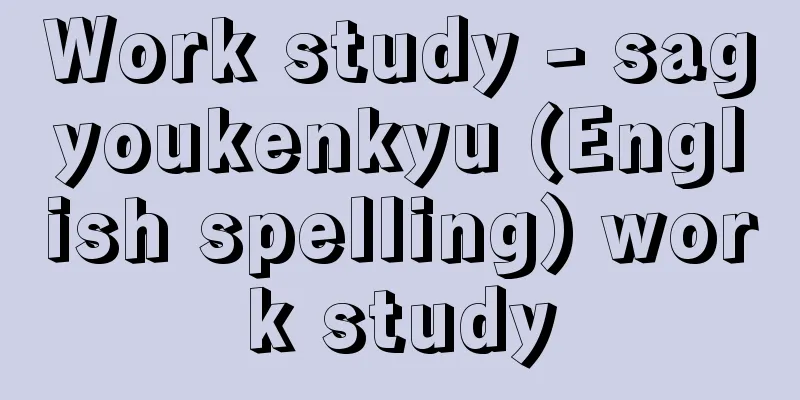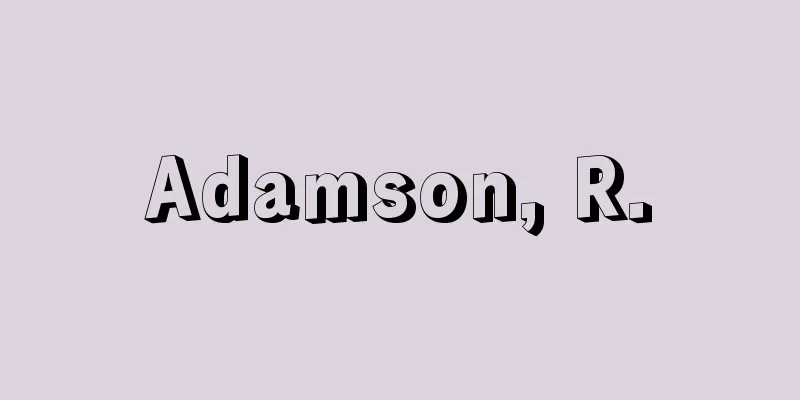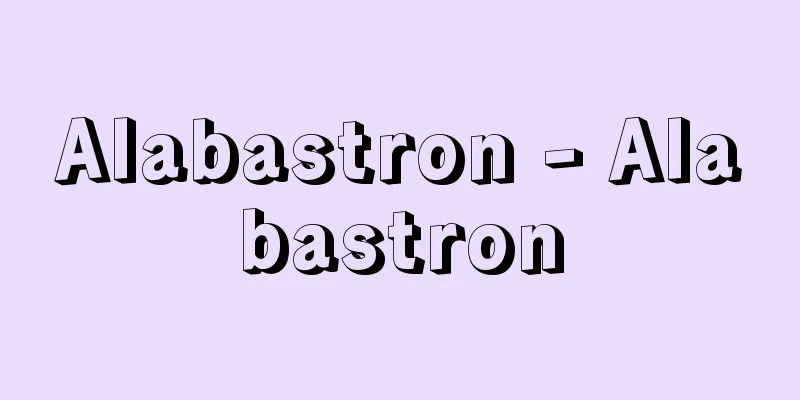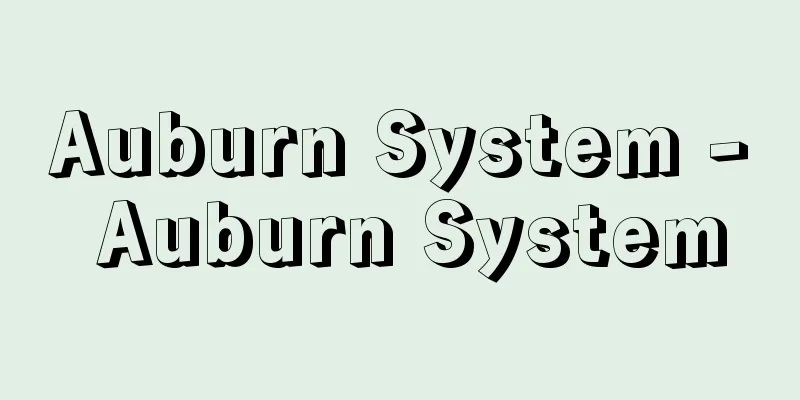Work study - sagyoukenkyu (English spelling) work study

|
In order to produce a certain quality and quantity of products as economically as possible, it is the investigation and study of the tasks and processes required for production, mainly from the perspective of the people who are actually engaged in the tasks. It is distinguished from process research, which investigates and studies the same thing from the perspective of the objects. Work study is also called work study, motion and time study, or method technology, and is one of the basic techniques of industrial engineering (IE). Its purpose is to explore rational work motions, improve and standardize work methods, materials, equipment, and tools, determine standard work volume and standard work time, and train workers based on these. The origins of work study can be found in the research on shoveling by F. W. Taylor, who is said to be the founder of scientific management, and the research on bricklaying by F. B. Gilbreth, also the founder of motion study, and the following idea was behind their research: there must be a most efficient scientific method for any task. This includes standardization of work methods, tools, equipment, etc. Furthermore, it is necessary to thoroughly train workers in the best work methods based on this, and to provide them with motivation to work through an appropriate reward system. Based on this idea, work study includes two techniques: one is method study, which systematically records, analyzes, and examines both current and future work methods to find effective work methods, and two is work measurement, which applies various methods to set the work content of a specific job and determines standard work time. These two techniques are closely related and are always applied in a fusion. Methodology research begins with identifying the type of work that needs improvement. To do this, it is necessary to analyze costs, defect rates, and other factors, as well as make an effort to gather information about work problems from the field. Next, the work that is the subject of the research is analyzed. Various methods are used for analysis, but the main ones are: (1) time study, which analyzes the progress of work and changes in various conditions over time, identifies the causes of fluctuations in the required time, and uses them as a basis for improvement; (2) motion study, which breaks down the movements of workers into several elements, analyzes them, and aims to eliminate unnecessary movements as much as possible and set standard movements; (3) analysis using film; and (4) PTS methods (predetermined motion time systems) such as the MTM method (method time measurement), the work factor method (WF method), and the DMT method (dimensional motion time). Next, improvement measures are proposed based on the results of the analysis using these methods. Finally, the selected improvement measures are implemented and checked to see if they have the expected effects. Work measurement is centered on time study. Traditionally, stopwatches were used, but because this method relies on the subjective judgment of the person measuring, and because there is uncertainty in setting standard times, the PTS method mentioned above has recently come to be used, in which standard times are determined in advance and basic standard times are estimated for specific tasks. [Mitsuo Takahashi] "Work Research" by Takayoshi Namiki and Shigeru Kuramochi (1984, Nikkan Kogyo Shimbun) " "Work Research and Work Management" by Masaharu Kawashima (1984, Japan Management Association) [References] | | | |Source: Shogakukan Encyclopedia Nipponica About Encyclopedia Nipponica Information | Legend |
|
一定の品質、数量の製品をできるだけ経済的に生産するために、生産に必要な作業や工程などについて、主として実際の作業に従事している人間の側から調査・研究すること。同じことを物の側から調査・研究する工程研究と区別される。作業研究はワークスタディ、動作・時間研究、ないしは方法技術ともよばれ、インダストリアル・エンジニアリング(IE)の基本的な技法の一つである。その目的は、合理的な作業動作の探求、作業方法、資材・設備・工具の改善と標準化、標準作業量と標準作業時間の決定、これらを基礎とした作業者の訓練にある。 作業研究の起源は、科学的管理法の始祖といわれるF・W・テーラーによるシャベル作業の研究、同じく動作研究の創始者であるF・B・ギルブレスによる煉瓦(れんが)積み作業の研究に求められるが、彼らの研究の背景には次のような理念があった。すなわち、どのような作業にも、もっとも能率のよい科学的方法といったものがあるはずである。これには作業方法の標準化、工具・設備などの標準化などが含まれる。また、作業員にはこれに基づいた最良の作業方法を十分に訓練させ、さらに適切な報償制度によって作業の動機づけ(モチベーション)を与えてやることが必要である。 作業研究はこのような考え方に基づいて、一つには、現在の仕事のやり方および将来の仕事のやり方の双方について、系統的に記録、分析、検討を行い、効果的な作業方法をみいだそうとする方法研究と、二つに、特定の仕事の作業内容を設定するために、各種の方法を適用して、標準的な作業時間を決めようとする作業測定の二つの技法が含まれる。そしてこれらの二つの技法は密接に結び付いており、つねに融合して適用される。 方法研究は、まず改善すべき仕事は何かを明らかにすることから始められる。そのためには原価や不良率などの分析とともに、仕事上の問題点を現場から吸い上げる努力が必要である。次に研究対象となった仕事の分析が行われる。分析には各種の方法が用いられるが、おもなものに次のようなものがある。(1)作業の経過や諸条件の変化を時間的に分析し、所要時間の変動の原因をつかみ、改善のよりどころとする時間研究、(2)作業者の動作をいくつかの要素に分解し、分析して、むだな動作をできるだけなくして、標準動作を設定しようとする動作研究、(3)フィルムを用いての分析、(4)MTM法(method time measurement)、ワーク・ファクター法(WF法)、DMT法(dimensional motion time)などのPTS法(predetermined motion time system、予定動作時間法)、である。次に、これらの方法による分析結果に基づいて改善策が案出される。そして最後に、選択された改善案が実施され、それが期待どおりの効果をもたらしているかどうかがチェックされる。 作業測定は、時間研究が中心である。従来はストップウォッチが用いられたが、これは測定者の自主的判断にゆだねられる部分が多く、標準時間の設定に不確実性を伴うため、最近は、あらかじめ標準時間を定めておいて、特定の作業について、それらの基本的標準時間を見積もろうとする、前述のPTS法が用いられる。 [高橋三雄] 『並木高矣・倉持茂著『作業研究』(1984・日刊工業新聞社)』▽『川島正治著『作業研究と作業管理』(1984・日本能率協会)』 [参照項目] | | | |出典 小学館 日本大百科全書(ニッポニカ)日本大百科全書(ニッポニカ)について 情報 | 凡例 |
Recommend
Monachosorum flagellare (English spelling) Monachosorum flagellare
…[Shigeyuki Mitsuda]. … *Some of the terminology ...
Amida
…In the Middle Ages, it was common to use the cha...
Ptilocercus lowii (English spelling) Ptilocercuslowii
... There are 17 species in 5 genera in the tree ...
Common yew
...In northern Japan, it is widely used as a gard...
Kannonji Temple
This temple belongs to the Daikakuji school of the...
Castling
…It usually becomes the most powerful queen. (2)C...
Olefinic Hydrocarbons - Olefinic Hydrocarbons
〘Noun〙 (Olefin is Olefin) ⇒ Ethylene, ethylene or ...
Large drift net - Omenagashiami
…Salmon and trout drift nets are typical. There a...
Picture book - Ehon
In Japan, picture books used to refer to picture ...
Ougo - Ougo
Year of death: October 1, 1608 (November 8, 1608) ...
Amindivi Islands (English spelling)
…the Amindivi Islands are a group of small coral ...
Medōn (English spelling)
…The inhabitants of the collapsed kingdoms migrat...
Kandokorofu - Kandokorofu
…Depending on the type of instrument, such as the...
Time signal - Houji
To inform the public of the time by means of soun...
Hitachiyama Taniemon
Year of death: June 19, 1922 Year of birth: Januar...









